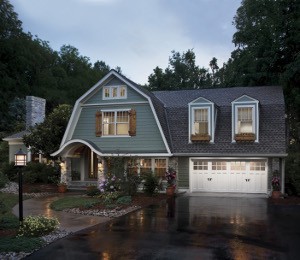
Whether you’re buying, selling or just trying to maintain your home’s value, studies show investing in curb appeal yields the best ROI in the new economy of real estate.
According to Remodeling magazine’s 2009 Cost vs. Value Report, seven of the top 10 value-yielding projects ranked by realtors involve the outside of the home. The magazine conducts the annual survey to determine the return on investment for the most common residential remodeling projects.
The biggest reason is cost: the most popular exterior replacement projects come in at less than $15,000. The project with the biggest return, a mid-range priced entry door replacement, costs less than $1,200. Second, is what you get in return: instant curb appeal and an increase in the perceived value of the home.
“Many buyers judge a house by its exterior,” says Marty DeWald, a real estate veteran with a 20-year track record as a top producer for ReMax Unlimited in Southwest Ohio. “A remodeled kitchen and bath can help sell a home, but curb appeal is what gets buyers through the door. If they don’t like what they see from the street, chances are they won’t waste time going inside.”
In a separate survey conducted by Stratamark Research and Clopay Building Products, real estate agents nationwide said replacing garage doors on a home can increase the asking price by four percent.
“Garage doors are a major exterior design feature, especially if the garage faces the street,” says DeWald. “Like the entry door project, an upgrade doesn’t necessarily cost a lot but it makes a big first impression, considering 73 percent of Americans now enter their home through their garage.”
Energy efficiency is another tipping point in the real estate market. Homeowners are looking for every opportunity to reduce costs of owning and maintaining a home long-term.
That being said, consumers are making smarter choices when it comes to the products they choose to invest in, to make sure they are getting the most “bang for their buck” in terms of value, curb appeal and energy efficiency.
“Homeowners are holding onto their discretionary dollars and need a compelling reason to move forward with a remodeling project,” says Pat Lohse, vice president of residential marketing for Clopay. “Right now their focus is on maintenance and repairs – the ‘need to haves’ vs. the ‘nice to haves.’ A broken appliance, entry door or garage door is an inconvenience homeowners aren’t willing to tolerate long-term compared to outdated wallpaper and paint colors.”
The extension of the $1,500 energy tax credit through December 31, 2010 is encouraging many homeowners to replace their garage or entry door sooner rather than later. In many cases, the 30% credit provides a “cushion” to help homeowners rationalize spending more to get a better looking door than they might have otherwise.
“We have experienced significant growth in sales of replacement doors that qualify for the tax credit, especially doors with insulated windows,” Lohse adds.
Clopay® offers an extensive portfolio of 1-3/8” and 2”-thick polystyrene and polyurethane insulated garage doors that meet the eligibility criteria. These durable, low-maintenance doors feature environmentally safe, CFC-free insulation “sandwiched” between two layers of heavy gauge steel with a thermal break. R-values range from 6.5 to 17.2.
In 2009, Clopay expanded its manufacturing portfolio to include both steel and fiberglass entry door lines featuring a variety of decorative windows, sidelites and transom options designed to coordinate with its leaded glass garage door windows. Many of these doors also qualify for the energy tax credit.
“Despite the decline in housing values, the Cost vs. Value report and other surveys reinforce that homeowners can recoup their investment in smart exterior upgrades that increase curb appeal, perceived home value and energy efficiency. Door replacement can be done in less than a day and the visual gratification is instant,” says Lohse.
For a list of Clopay garage doors and entry door models that qualify for the energy tax credit, visit www.clopaydoor.com or call 800-225-6729. For additional information on the energy tax credit, visit www.energystar.gov.